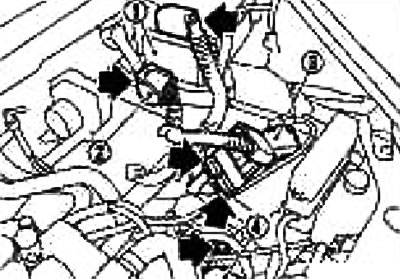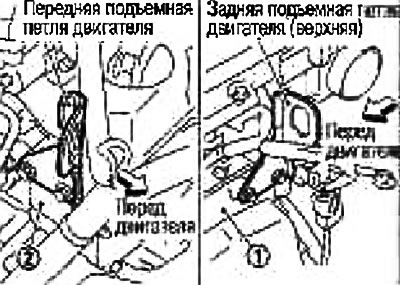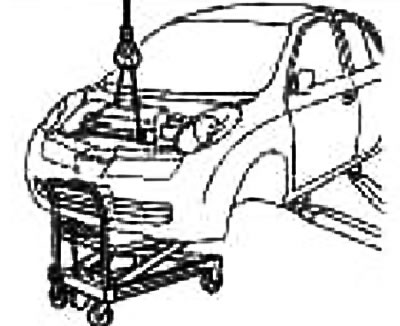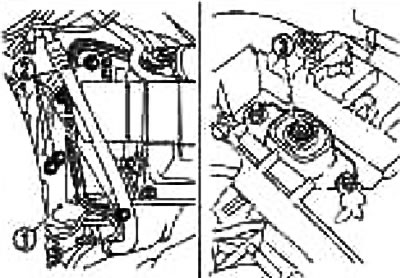
1. Insulator of the left engine support; 2. Bracket left engine mount (from the side of the car); 3. Bracket left engine mount (from the gearbox side); 4. Rack of the right support of the engine (the shape may differ from that shown in the picture); 5. Insulator of the right engine support; 6. Right engine mount bracket (upper); 7. Right engine mount bracket (lower); 8. Bracket rear engine mount; 9. Rear torque rod; 10. Engine rear mounting bracket
Attention:
- Stop the vehicle on a level and firm surface.
- Chock the rear wheels front and rear.
- If the engine is not provided with lifting eyes, select them and bolts from the parts catalog.
- Always carry out work in a safe environment, avoid performing unforeseen operations.
- Do not start work until the exhaust systems and engine coolant have cooled sufficiently.
- If the required components or operations are not covered in the chapter Mechanical part of the engine, see the relevant chapters.
- Always lift the engine at the indicated points.
- Use either a 2-post lift or other self-contained lift at your disposal. If for some reason it is necessary to use a bead stand, before starting work, in order to avoid shifting the center of gravity in the rear direction, support the car at the point of support on the rear axle with a telescopic stand or similar device.
- For the support points for the lift and jack on the rear axle, see chapter General information and maintenance, «Garage Jack, Safety Beds and 2 Post Lift».
Removing
Description of works
Remove the engine and transmission from the vehicle and separate the engine and transmission.
Preparatory work
1. If the engine can be hung on a winch, remove the hood.
2. Relieve fuel pressure. See chapter Engine management system.
3. Drain the engine coolant. See chapter Syst. lubricants and systems engine cooling.
4. Remove the following components:
- front wheels;
- protective pad from the front right and left fenders;
- front exhaust pipe; see chapter Accelerator fuel system and exhaust system;
- drive belts; see above section «Drive belts»;
- duct; see above section «Air cleaner and air duct»;
- battery;
- radiator; see chapter Syst. lubricants and systems engine cooling.
In the engine compartment on the left
5. Disconnect the connectors and terminals from the following components:
Note: Remove the ECM (1) from the bracket and disconnect the two electrical connectors.
Caution: Do not hit the ECM.
Disconnect the intermediate connector (2) the main wiring between the vehicle and the engine compartment sub-ECM.
Disconnect the connectors from the positive battery terminal (3).
Disconnect the ground wire from the transmission side (4).

6. Disconnect the heater hose. Plug the hose with a plug to prevent engine coolant from escaping.
7. Disconnect the shift cable from the gearbox. See chapter Manual Transmission.
8. Disconnect the clutch tube from the transmission side and temporarily secure to the vehicle.
Install a plug to prevent leakage of fluid from the clutch.
9. Remove the crank angle sensor (POS) from the gearbox.
Caution: Handle the sensor with care, do not drop or hit it.
In the engine compartment, front and right
10. Disconnect the ground wire between the alternator bracket and vehicle.
11. Remove a rack of the right support of the engine, an arm of the generator and the generator.
12. Remove the A/C compressor with pipes connected from the engine and temporarily secure it to the vehicle with a rope so as not to stretch the pipes.
13. Remove a protective overlay of a fuel tube. See section «Fuel injectors and fuel pipe».
14. Disconnect the fuel hose. Seal the hose with a plug to prevent fuel from escaping.
Under the bottom of the car
15. Remove the ABS wheel sensor from the steering knuckle.
16. Remove the brake caliper from the steering knuckle. Temporarily secure the caliper to the side of the vehicle with a rope, etc., so as not to stretch the brake hose. See chapter Brake system.
17. Remove the right and left power shafts. See chapter Front axle and suspension.
18. Remove the rear jet rod (1).

Withdrawal operations
19. Attach the engine lifting eyes to the front left of the cylinder head (1) and rear right of the cylinder head (2) hang the engine on the winch.

Note: Use the standard hinges on the front and back sides.
Tightening torque: 16.6-23.5 Nm (1.7-2.3 kg m)
From the front, remove the wiring harness bracket under the fuel pipe cover and attach it to the bracket mounting hole. See section «Fuel injectors and fuel pipe».
20. Raise the winch to a sufficient height for comfortable operation, support the bottom of the engine, or use a cart with a lifting table (suitable special tool), or two safety stands and adjust the winch tension.

Caution: Place a piece of board or similar object as a support surface for stability. Make sure that the hanging chain or lifting hook does not come into contact with the A/C pipes or the vehicle (hood grille). Also make sure that they will not interfere with the work.
21. Remove the mounting bolts (2) right engine mount bracket (top) (1).
22. Unscrew the nut (3) from the bolt on the left engine mount.

23. Carefully lower the lift table cart or suitable jack (or raise the lift) and remove the engine and transmission from the vehicle.
If you are going to lower the engine side, do this operation in sync with the winch.
Attention:
- Make sure that no part of the engine touches the body.
- Make sure that all pipes, electrical wiring, etc. are disconnected.
- Make sure that the hanging chain or lifting hook does not come into contact with the A/C pipes or the vehicle (hood grille).
- When removing the engine and transmission assembly, do not allow the vehicle to fall off the lifting device due to a shift in the center of gravity.
- If necessary, support the vehicle with a jack or equivalent at the rear.
Branch Operations
Separate the engine and gearbox on level ground as follows:
Caution: During this operation, securely support the engine by placing a block of wood under the engine oil pan, transmission oil pan and hanger beam and hang from the lifting eyes with a winch.
24. Remove the generator. See chapter electrical equipment.
25. Separate the engine from a transmission. See chapter Manual Transmission.
Installation
Installation is carried out in the reverse order of removal, taking into account the following:
- Be careful not to damage the engine mount insulator or expose it to oil.
- If installation direction is specified, refer to the component drawing above.
- Make sure all leg insulators are seated correctly and tighten the mounting nuts and bolts.
Check after installation
Before starting the engine, check the level of coolant, engine oil and working fluids. If the level is low, top up and bring to the required level.
Check for fuel leaks as follows:
- Turn the ignition key to position «ON» (without starting the engine). After pressurizing the fuel lines, check for fuel leaks at the joints.
- Start the engine While increasing the engine speed, check again for fuel leaks at the fuel line joints.
Let the engine run and check for unusual noise or vibration.
Warm up the engine well and check for leaks of coolant, engine oil, fluids, fuel, and exhaust gases.
Bleed the pipes and hoses of the relevant systems, such as the cooling system.
After the engine has cooled down, check the coolant, engine oil and fluid levels again. Top up if necessary and bring to the required level.